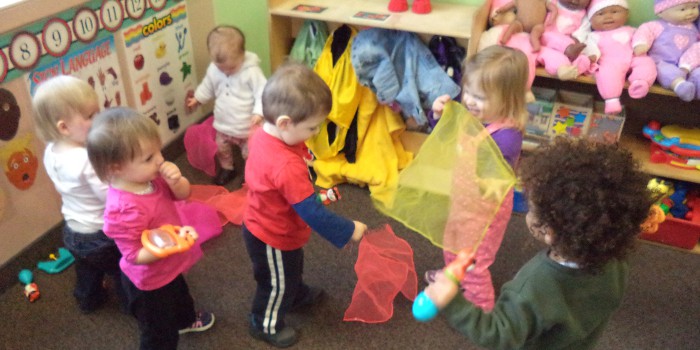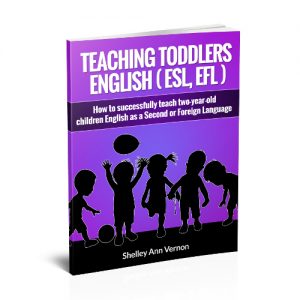Here’s what sounds like the perfect English lesson for toddlers at nursery, kindergarten, or preschool. It’s well-thought-out, varied, and thoroughly planned. Yet it was a failure! This post explains how to teach toddlers English successfully and with very little preparation time.
The "Perfect" English Lesson for Toddlers
“I just gave a trial lesson with 2-year-old children, and it didn’t go well! First, I tried to get them to do actions to a greeting song and find pieces of a puzzle I had spread on the floor. Then, I introduced the hand puppet from the mystery box. That part was probably the moment they were engaged most. Next, we did an action song, singing with running, jumping, walking up and down, etc.
Only one kid was doing it; the girl refused to participate the other boy was just wandering around climbing up and down. I understand I can’t expect much from this age group, but I was disappointed at their indifference to the action songs I had down as winners. Finally, it came to the point that the girl didn’t even want to be there. So she left with her mum, not even halfway through the lesson.
The disaster continues
Then we had storytime, but it was still that one boy who was paying attention while the other one wasn’t interested, attempting to open the door and go out a few times even with his mom being present in the classroom. I used a lot of music during the lesson and a lot of body movement, but I wonder if it is all too new to them, so they get bored. Alternatively, it is me who didn’t know how to make it fun. You are an expert, so can you please advise me on what went wrong and what I could do to improve?”
Learn from failure
This lesson must have taken some preparation, and I can understand how disappointed the teacher was when it didn’t go well. Don’t be disheartened! We learn from what does not work! This lesson just needs tweaking to come down to the toddlers’ level. It’s easy to improve this lesson and spend less time preparing too.
How can we improve this toddler English lesson?
Natural shyness at the first encounter
Firstly one crucial point to make is that this teacher has never met these toddlers before. It can be challenging to get two-year-old children to join in anything, simply because they are shy and overwhelmed at meeting a new person. So in the first lesson, don’t have high expectations!
There is too much structure
During an English lesson for toddlers, it’s better to prepare LESS and go with the flow rather than impose your plan. If you see that the activity you had planned is not making your toddlers curious, stop right away and try something else. When you hit on something that they do like, milk it to the full!
Be gentle, and don’t try to make a toddler do anything. Toddlers like to explore for themselves. They hate to be told what to do, especially by someone they have only just met! So instead, try to attract them to you.
Puppets
During your lesson, you found that the puppet attracted your pupils. Go with this and drop the rest; you can always use it in the next class.
It might be that the puppet (who only speaks English) becomes a best friend to your toddlers. The puppet can be shy or sad and need reassurance. He can want to know how to say words in the kids’ native language but have terrible pronunciation that makes the kids fall about laughing. Then he says the word in English. Gradually he’ll be able to coax the toddlers to tell him what things are called in English, over time, as they get to know him.

Go with the flow
In an English lesson for toddlers, the idea is first to engage them and second, hope they learn. So, if they unexpectedly become fascinated with a box, when you want them to play with a puppet, go with the box! The box is an English box! It talks! Hello, box! What’s your name? Then the box gets hungry, and everyone can feed it objects or flashcards.
When you stumble across something simple the kids love, let it evolve and develop in free play. It might be hiding the puppet and not finding it (though the kids can see where it is). All this happens in English, as you repeat the same thing over and over. For example, “Where is Elfie? Where is Elfie? Where is Elfie?” The kids will be calling out in their native language, “He’s over there, behind you!” But you still can’t see Elfie because every time you turn around, he’s still behind you.
Silly stuff
Bring in two boxes and put the puppet under one. Look for it. You can’t find it anywhere. Lift up the wrong box. Where is Elfie? Is he under the box? No! He’s not under the box. Where is he? Look somewhere else, then lift up the wrong box again. Still no puppet. Where is Elfie? Repeat the phrases.
Toddlers absolutely love all that kind of silly stuff! And they will be learning English all along, with your repetition of short phrases and vocabulary. When you finally find Elfie, it’s a big party, and maybe the kids will want a kiss from him (not in the first lesson, perhaps).
Teaching Toddlers English, by Shelley Ann Vernon
If you like these ideas, you’ll love my Teaching Toddlers Report, compiled from ideas that work, contributed by 250 Toddler Teachers!
They are packed with dos, don’ts, tips, and great activities that require no preparation!
This short book will have you ready to bounce into preschool feeling full of fun and give the best English lessons for toddlers! Add on the stories too.
More great tips for teaching toddlers English
Keep language simple and repeat the same things
You can’t chat away to toddlers in English as if they were bilingual. They won’t have a clue what you are talking about, and it will most likely alienate them. However, if you say single words and short phrases repeatedly, they will catch on over time.
Use props and more props!
Any English lesson for toddlers needs lots of props to touch and play with, be they touchy, feely, noisy, squidgy, or smelly! Have different toys to pick up when you name them. Play with the toys and name them (maybe just two toys), then see if they will touch the toy you name (teddy or car). When they know those two, they will find it hilarious when you touch the wrong one. You might put a bag of different coloured scarves in a box and scraps of material with different textures. Pull one out and quickly hide it inside your jumper, then peek at it and wonder what colour it is – and show a tiny bit, then hide it again.
Closing ritual
You can do a finger play and rhyme in a circle with the mums or dads for a closing ritual. The first few times, do it quickly since the kids won’t have a clue what it means and will lose interest fast, though they may be intrigued that mummy and teacher are interacting in this curious way. Then, as the routine becomes familiar, the kids may join in.
(Mum or dad will probably do this finger play at home too, and that will help. It’s good to give some teaching tools like this to parents to empower them and make them feel involved.)
How long should an English lesson be?
Keep English lessons for toddlers short. Twenty minutes of play should be enough, plus five minutes for arrivals with greetings and five minutes for a biscuit and to leave. As you get better at playing with toddlers in English, you’ll be able to expand to thirty minutes, with five on each side for coming and going.
A key tip to take away
Remember, the critical thing with two-year-olds is that you can’t force them to do what you want. Instead, you have to lure them in, allow them to play freely, follow their interests, and mesh in with them rather than the other way around!
Your comments are welcome
Please leave lots of comments in the box below, and we can exchange ideas!
And check out my Report if you want more fun ideas for your English lesson for toddlers. I recommend you add on the stories too (optional).
Shelley Ann Vernon, Teaching English Games


8 thoughts on “The perfect English lesson for toddlers and why it failed”
That was very useful. Thank you!
Hello. Thank you very much for the tips above. I find them really useful. I teach English to two year olds and yes sometimes it gets quite tricky!!
that was great, thanks.
Thank you for your experienced comments. I appreciate the way you “go with the flow” and encourage the teacher to be natural and fun. If a child “feels” then he/she learns. It is the emotions that need to be addressed. If the child is curious, you´ve got them. Your comment is a perfect example of this.
Dear Angie, thanks for your comment, it’s most useful, perhaps other teachers will be inspired to try this approach. All the best, Shelley
Very useful!!!!!! Thank you!!!!
Really thank you! Very useful suggestion!!
Hello, these helpful comments and ideas are from Clare, which I am posting with her permission:
Thank you for your creativity and openness in sharing your fun material and experiences of teaching toddlers. I was used to teaching Adult fairly proficient ESL students, so this experience I was thrown in the deep end and felt I was drowning!
When I came to Hungary my friend who is a Teacher took me to a crèche where she hid behind a white netting material and pretended to be shy before introducing a puppet and getting the new group of toddlers to speak their names. She also used brown paper with some water and paint brushes to splash a weather song and to draw a sun. The young toddlers enjoyed this hands on fun game.
In one crèche as you described, one little boy intensely listened to a story being read whilst another little one wandered around and didn’t want to participate in the group nor in the activity.
At the moment my youngest student online is 7 years and I using the Cambridge Starters story fun. But she shows me her own toys so we play. I have a puppet and she has a soft toy and we play! She loves the 5 little monkeys jumping on the bed plus 5 little duckling went swimming one day.
Yesterday she excitedly hid behind her chair as we said the 5 little monkeys swinging in the trees, teasing Mr Crocodile!
Yes to teach little children it is fun and necessary to be playful and flexible and go with the flow. A little child would normally learn at mum’s side not via a computer!